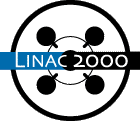
William M. Fawley (for the DARHT-II Collaboration, LBNL)
The second axis of the Dual-Axis Radiographic Hydrodynamics Test Facility (DARHT-II) is a long pulse (2.0-microseconds), moderate energy (20-MV) induction linear accelerator presently under construction at Los Alamos National Laboratory. In order to obtain a sufficiently small spot size at the x-ray converter target, a design goal for the accelerator was the production of a 2-kA current beam with a normalized transverse emittance at exit of 1000 pi mm-mrad (4*RMS) or less. Among other beam dynamics challenges associated with such a low emittance are:
(1) transport of both the main beam body AND the low energy head and tail through the injector and beyond, minimizing or eliminating particle loss near powered acceleration gaps
(2) limiting the initial excitation levels and growth of the beam breakup instability (BBU) through the 88 acceleration gaps.
(3) control of the background gas pressure and resultant beam-induced collisional ionization, which leads to time-dependent ion focusing and growth of the ion hose instability.
(4) developing intelligent steering algorithms for the dipole correctors present in the solenoidal magnet focusing lattice compatible with the diagnostic capabilities and expected low repetition rate (~1/minute) of DARHT-II.
This talk will first give a brief overview of the current status of the DARHT-II injector and accelerator construction, and then review our current understanding of the above dynamics issues and the design tradeoffs we made to optimize the brightness of the output electron beam. Within this review, we present some of the the results of various beam dynamics simulations, together with both theoretical and experimental RF impedance measurements that led to our final design for the transport lattice and accelerator cell geometry.
* This work was supported by the U.S. Dept. of Energy under Contract No. DE-AC03-76SF00098
Comments or Questions to
linac2000@slac.stanford.edu